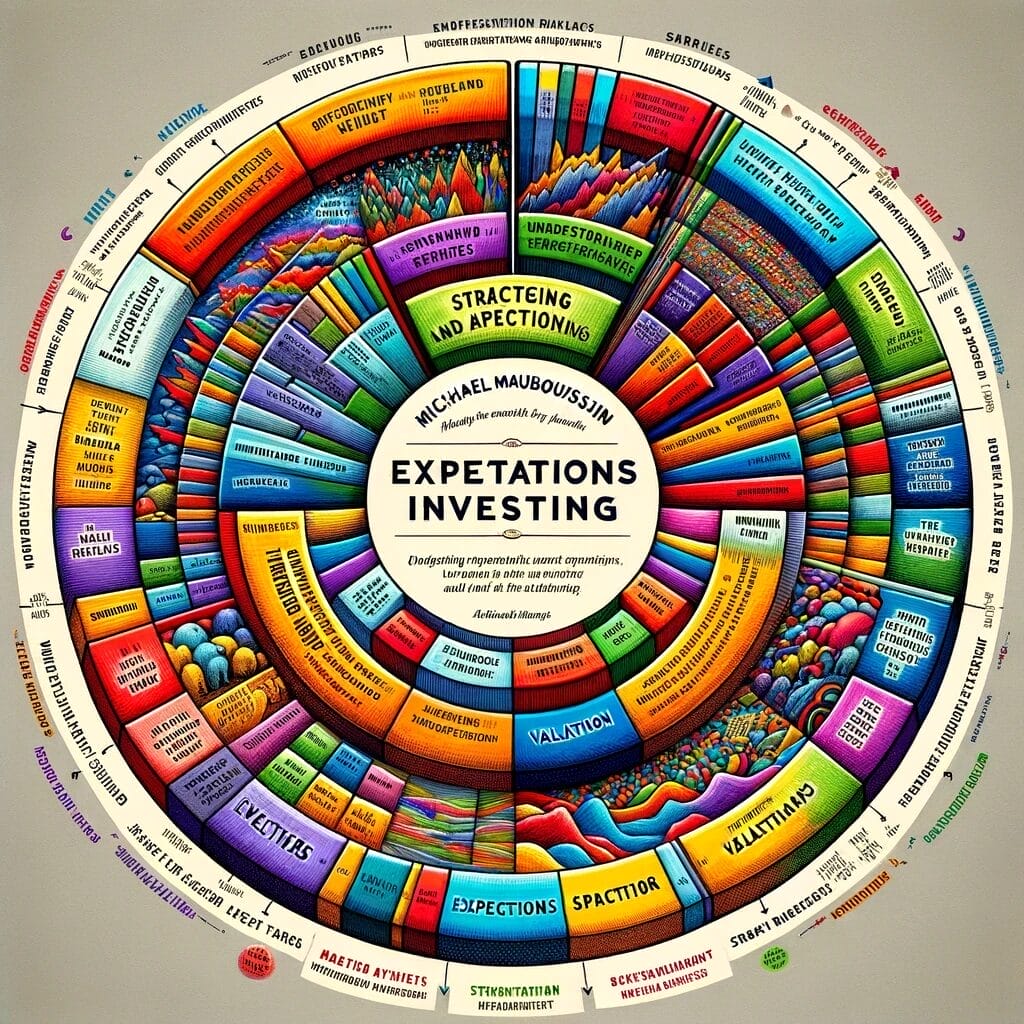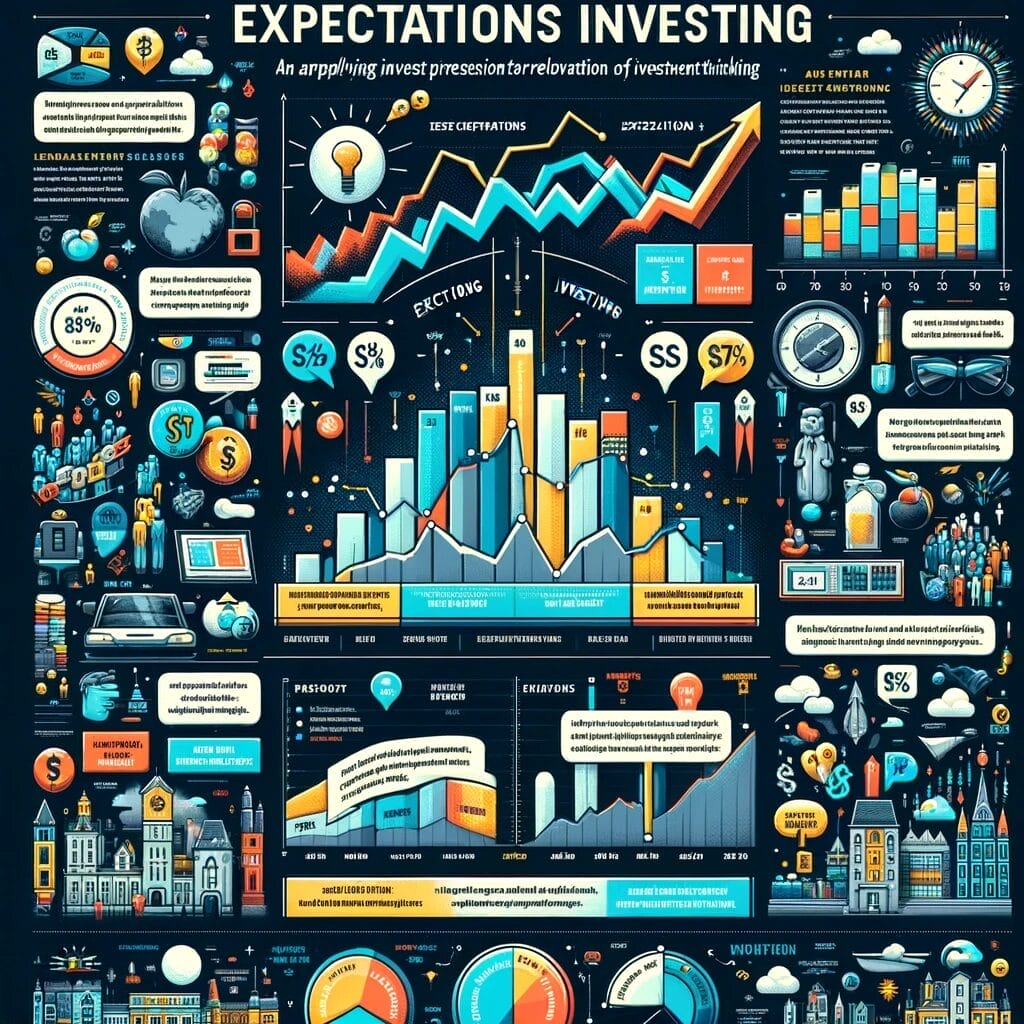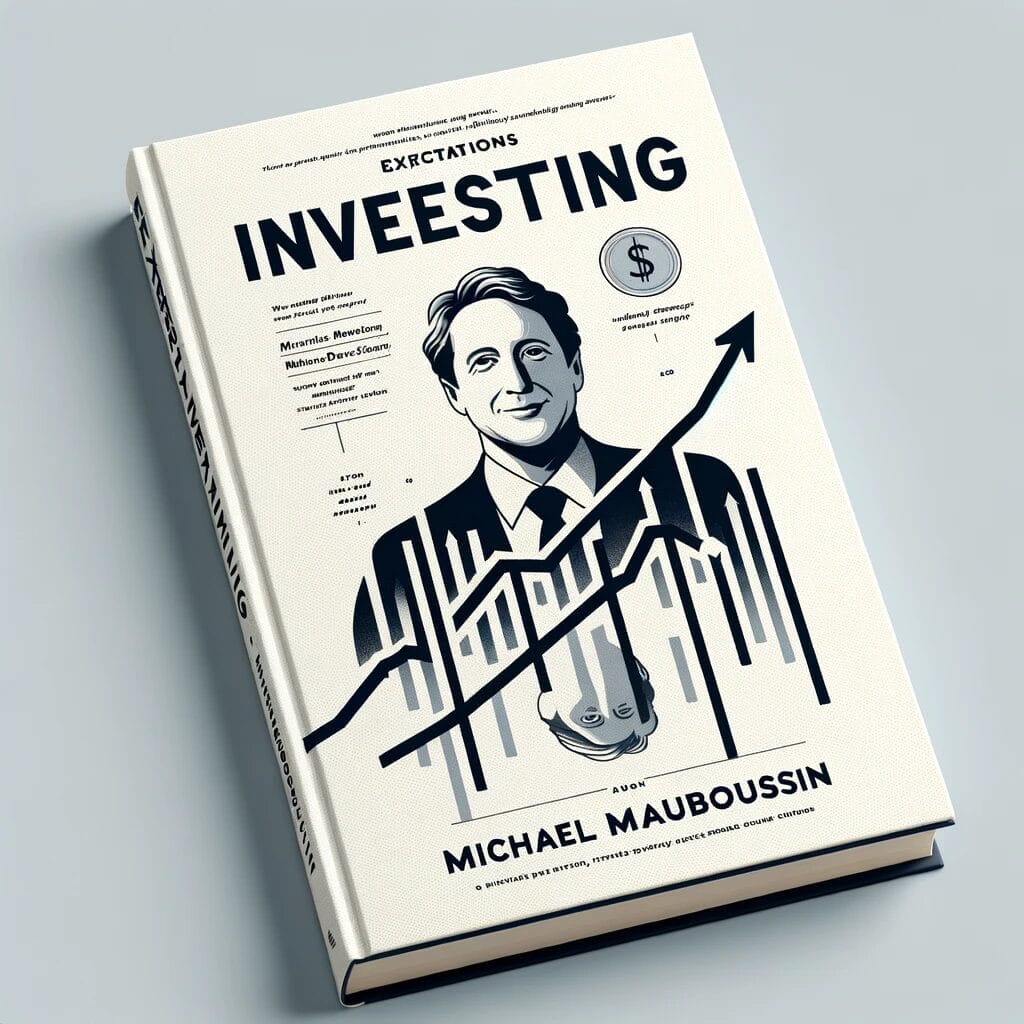Investing is not just about numbers and charts; it’s about understanding what those numbers represent and how the market interprets them.
Expectations Investing by Alfred Rappaport and Michael Mauboussin offers a unique lens to view the investment landscape, focusing on discerning the future financial performance implied by current stock prices.
This approach contrasts traditional investment methodologies, promising a more nuanced and forward-thinking strategy.
In this article, you will learn:
- Book Overview
- Understanding the Relationship Between Stock Prices and Expectations
- 4 Principles of the Book
- Analyzing a Company Using Expectations Investing.
Let’s dive into how Expectations Investing can revolutionize your investment strategy and make you a better investor.
Book Overview

Expectations Investing: Reading Stock Prices for Better Returns is not just a book; it’s a revolutionary approach to investment analysis authored by Michael J. Mauboussin and Alfred Rappaport.
The book’s essence lies in its challenge to conventional investing wisdom, pivoting from a focus on historical data to the anticipatory nature of market expectations.
It provides a comprehensive guide for investors to navigate stock prices as numbers and as narratives about companies’ future financial performance.
Understanding the Relationship Between Stock Prices and Expectations
The book’s first part lays the groundwork by explaining how stock prices reflect the collective market’s expectations about a company’s future earnings and growth.
For example, suppose a company’s stock price increases significantly without any corresponding change in its historical financial performance. In that case, it suggests that the market expects better future earnings or growth from the company.
The authors use real-world examples, such as a sudden surge in the stock price of a tech company following the announcement of a new product, to illustrate how investor expectations about future profits are embedded in stock prices.
Learning How to Infer Expectations from Current Prices
Mauboussin and Rappaport dive into methodologies for inferring these market expectations from current stock prices in the second part.
They introduce the concept of “expectations investing” to reverse-engineer the market’s assumptions. For instance, they might analyze a company like an electric vehicle manufacturer, breaking down its stock price to uncover what sales growth rates investors are assuming over the next decade.
This section is rich with examples, including dissecting financial metrics and market indicators to derive the embedded expectations in various sectors.
Applying Knowledge to Make Better Investment Decisions
The book’s final part applies this understanding to make informed investment decisions.
Here, the focus shifts to identifying when the market’s expectations are misaligned with one’s analysis of a company’s potential. The authors present case studies, such as a pharmaceutical company embarking on a promising but risky new drug development, demonstrating how to spot investment opportunities.
They detail strategies for investing when expectations are too low (undervalued stocks) and advise caution when they are too high (overvalued stocks), offering practical steps for adjusting one’s investment portfolio accordingly.
Through these three segments, Expectations Investing equips investors with the knowledge and tools to navigate the stock market more effectively by understanding, inferring, and acting on market expectations. The book’s real-world examples and practical applications illustrate the transformative power of adopting an expectations-based approach to investing.
4 Principles of the Book

Principle 1: Market Expectations Are the Benchmark
The first principle suggests that understanding and leveraging market expectations is key to successful investing.
Example: Consider a company like a fast-growing tech startup. Its current stock price may be high – not because of its present earnings – but because the market expects rapid growth in the future.
An investor using expectations investing would analyze whether the expected growth rates are achievable. If the investor believes the market’s expectations are too pessimistic or optimistic, there may be an opportunity to buy or sell the stock before the general market adjusts its view.
Actionable Insight: Review analyst forecasts and market sentiment indicators for your target investments regularly. Compare these with your growth projections to identify potential mispricings.
Principle 2: Price Reflects Perceived Value, Not True Value
This principle emphasizes the distinction between a company’s perceived and intrinsic market value.
For example, a pharmaceutical company announces a promising new drug. Initially, the market may overestimate the drug’s impact on the company’s revenue, leading to an inflated stock price.
An expectations investor would evaluate the drug’s market potential, considering factors like competition, patent life, and regulatory hurdles, to determine if the stock’s price accurately reflects its true value.
Actionable Insight: Conduct thorough due diligence on major company announcements and sector trends. Use this analysis to assess the sustainability of market reactions and identify investment opportunities.
Principle 3: Look Forward, Not Backward
Investors are encouraged to focus on forecasting future performance rather than relying solely on historical data.
For example, a retail chain announces an aggressive expansion plan.
While historical data may show steady revenue growth, an expectations investor would model the impact of the expansion on future revenues, margins, and capital expenditures to gauge whether the market has fully appreciated the risks and rewards of the expansion plan.
Actionable Insight: Develop forward-looking financial models that incorporate baseline projections and best-case and worst-case scenarios. This helps understand the range of possible future outcomes and their implications for stock valuation.
Principle 4: News and Events as Catalysts for Re-Evaluation
News and events should prompt investors to reassess their investment thesis.
Example: Suppose new legislation is introduced that could significantly impact the business model of online platforms.
An investor practicing expectations investing would quickly evaluate how this legislation might change the future earnings outlook for companies in this sector. If the market’s reaction is deemed overblown, it could present a buying opportunity for undervalued stocks or a selling opportunity for overvalued ones.
Actionable Insight: Stay informed about industry news and global events. Develop a system for rapidly assessing their potential impact on your investment portfolio and adjust your positions as necessary.

Key Takeaway
By expanding on these principles with concrete examples and actionable insights, investors can better understand how to apply the concepts of expectations investing to their strategies. This approach enhances the ability to identify undervalued opportunities and helps manage risks more effectively.
Analyzing a Company Using Expectations Investing
Step 1: Identify Key Value Drivers
The initial phase of analyzing a company through the lens of expectations investing involves a meticulous assessment of the company’s key value drivers.
These drivers are the foundational elements that will influence the company’s ability to generate future cash flows and, consequently, its valuation.
Understanding these drivers is critical for accurately inferring the market’s expectations from the current stock price.
Comprehensive Analysis of Financial Statements
Revenue Drivers: Look beyond top-line growth to understand the components driving revenue. For a software company, this might involve subscription models, licensing fees, or sales of proprietary technology. Assess the sustainability of these revenue sources and the potential for scale.
Cost Structure and Profit Margins: Evaluate the company’s cost efficiency and impact on profit margins. Analyze the cost of goods sold (COGS), labor costs, and operational efficiencies for a manufacturing entity. Margins can be a significant indicator of competitive advantage and operational effectiveness.
Capital Efficiency and Investment Requirements: Determine how effectively the company utilizes its capital to generate earnings. This includes examining return on invested capital (ROIC), capital expenditures (CapEx) requirements for growth, and working capital management. This might involve analyzing a retail chain’s store expansion strategies and inventory turnover rates.
Industry and Competitive Landscape Analysis
Market Position and Competitive Advantage: Assess the company’s position within its industry and any sustainable competitive advantages, such as brand strength, proprietary technology, or regulatory barriers to entry. Patents and drug pipeline strength are key value drivers for a pharmaceutical firm.
Industry Growth and Dynamics: Understand the broader industry context, including growth trends, regulatory environment, and cyclical factors. Consider factors like oil price volatility, renewable energy adoption rates, and regulatory changes when evaluating an energy company.
Step 2: Infer Market Expectations from the Current Stock Price Using Reverse DCF
A reverse DCF analysis starts from the premise that a stock’s current price reflects the collective market’s assumptions about a company’s future cash flows.
By reversing the traditional DCF model, investors can extract these embedded expectations about growth rates, profit margins, and capital efficiency.
Conducting a Reverse DCF Analysis
Determine the Current Enterprise Value: Calculate the company’s current enterprise value (EV), which includes the market capitalization, debt, and cash on the balance sheet. This value represents the total value the market is assigning to the company.
Estimate the Weighted Average Cost of Capital (WACC): The WACC is the average rate of return a company is expected to pay its security holders to finance its assets. It’s crucial for discounting future cash flows. Factors influencing WACC include the risk-free rate, market risk premium, and the company’s debt/equity ratio.
Select a Forecast Horizon: Consider the industry’s visibility and the company’s growth phase to decide on an appropriate forecast horizon, typically 5 to 10 years. This is the period over which you’ll explicitly forecast cash flows.
Solve for Implied Future Cash Flows: Using the current EV and WACC, solve for the annual cash flows the market implicitly forecasts over the selected horizon. This is done by adjusting future cash flows in the model until the discounted cash flows (DCF) sum equals the current EV.
Example: Suppose a technology firm has an EV of $100 billion, and you’ve estimated a WACC of 8%.
If the market expects the company to grow significantly due to new product launches, the reverse DCF might reveal that the current EV implies a compounded annual growth rate (CAGR) of future free cash flows of 15% over the next five years.
Analyzing the Implied Expectations
Compare Implied Growth Rates to Historical and Industry Benchmarks: Assess whether the implied growth rates are realistic by comparing them to the company’s historical growth rates and those of its peers. If the market’s expectations seem overly optimistic or pessimistic, it may indicate a mispricing.
Consider the Sustainability of Implied Margins and Returns: Analyze whether the implied profit margins and return on invested capital (ROIC) are attainable, given the company’s competitive positioning and industry dynamics.
Evaluate Capital Expenditure Requirements: Consider if the implied capital expenditure levels are reasonable for sustaining the forecasted growth. This includes assessing the industry’s capital intensity and the company’s historical investment levels.
Leveraging Insights from Reverse DCF for Investment Decisions
The reverse DCF analysis provides a quantitative foundation for evaluating whether the market’s expectations are overly bullish or bearish. By understanding the assumptions baked into the current stock price, investors can make more informed decisions on buying, holding, or selling shares based on their analysis of the company’s prospects.
Step 3: Analyze the Feasibility of Market Expectations

After identifying the market’s expectations for a company’s future performance, the next step is thoroughly evaluating these expectations’ feasibility.
This involves a detailed analysis of the company’s business model, competitive advantage, industry conditions, and broader economic environment to determine if the implied future growth rates, profit margins, and cash flows are attainable.
Evaluating Company-Specific Factors
Business Model and Competitive Advantage: Assess the sustainability and scalability of the company’s business model. Consider its competitive moat—such as brand strength, proprietary technology, network effects, or cost advantages—and whether these can support the growth and profitability implied by market expectations.
Management Team and Strategy Execution: Evaluate the track record and capability of the company’s management team in executing its strategy and navigating past challenges. Leadership is crucial in achieving growth targets and operational efficiencies implied by market expectations.
Financial Health and Flexibility: Analyze the company’s balance sheet strength, liquidity ratios, and access to capital. Financial stability is key to supporting the investments in innovation, expansion, or acquisitions necessary to meet or exceed market expectations.
Industry and Competitive Landscape Assessment
Market Size and Growth Potential: Estimate the total addressable market (TAM) and the company’s potential market share. This helps assess whether the growth rates implied by market expectations are achievable within the industry’s confines.
Competitive Dynamics and Market Position: Analyze the company’s position relative to its competitors, including any threats from new entrants, substitute products, or changing consumer preferences. A dominant market position may support optimistic market expectations, while a competitive or fragmented industry landscape might make high growth targets less attainable.
Regulatory and Environmental Factors: Consider any regulatory challenges or changes that could impact the company’s ability to meet market expectations. This includes industry-specific regulations, environmental considerations, and geopolitical risks.
Step 4: Develop Scenarios and Sensitivity Analysis

After assessing the feasibility of the market’s expectations, investors should consider a range of potential future scenarios that could affect the company’s performance.
This step involves creating optimistic, realistic, and pessimistic scenarios to understand how different outcomes might impact the valuation.
- Creating Scenarios: Develop detailed scenarios that account for economic conditions, industry trends, competitive dynamics, and company-specific factors like new product launches or market expansion efforts.
- Sensitivity Analysis: Apply sensitivity analysis to each scenario, adjusting key assumptions such as growth rates, profit margins, and capital expenditures to see how changes affect the company’s projected cash flows and valuation. This helps identify which variables have the most significant impact on value.
- Evaluating Outcomes: Compare the range of outcomes from the scenarios to the market’s current expectations as inferred from the stock price. This comparison can highlight potential mispricing if the market’s expectations seem too optimistic or pessimistic relative to your scenarios.
Step 5: Make Investment Decisions Based on Discrepancies
With a comprehensive understanding of the company’s potential future performance across different scenarios, investors can now identify discrepancies between their analysis and the market’s expectations.
- Identifying Opportunities: Look for stocks with a significant discrepancy between your valuation under realistic scenarios and the market’s current valuation. Stocks priced below your conservative estimates may present buying opportunities, while stocks above your optimistic estimates might be candidates for selling or avoiding.
- Risk Assessment: Incorporate the results of your sensitivity analysis to assess the risk associated with each investment opportunity. Consider the probability of each scenario and the potential impact on the stock’s valuation.
- Decision Making: Based on this comprehensive analysis, make informed decisions about buying, holding, or selling stocks. Your decisions should align with your investment strategy, risk tolerance, and portfolio diversification goals.
Step 6: Monitor and Update Your Analysis
Expectations investing is a dynamic process that requires ongoing vigilance. Market conditions, industry dynamics, and company-specific factors can change, impacting the feasibility of the market’s expectations.
- Continuous Monitoring: Keep abreast of developments that could affect your investment thesis, such as financial reports, news releases, industry trends, and macroeconomic changes.
- Updating Your Analysis: Regularly revisit and update your scenarios and sensitivity analysis in light of new information. Adjust your investment positions as necessary to reflect changes in your assessment of the company’s future performance relative to market expectations.
- Staying Informed: Utilize various sources, including financial news, analyst reports, and industry publications, to ensure your analysis is based on the most current and comprehensive information.
By meticulously following these steps, investors can systematically apply the principles of expectations investing to identify undervalued or overvalued stocks and make more informed investment decisions.
This approach enhances the potential for superior returns and helps manage investment risks more effectively.
Investor Takeaway
To wrap up our discussion of Expectations Investing, we need to discuss the importance of working backwards. Investing is all about assumptions, as the markets have no certainties.
Using a reverse DCF allows us to work backwards from the one certainty in the markets: the price.
That is a powerful concept and one underutilized by other investors.
Expectations Investing allows investors to understand how to use a reverse DCF to its best advantage.
By utlitizing the processes and ideas from the book, you can start to build a better process. You can look at the complete picture surrounding a company. For example, looking at the competitive advantage period on a deeper level. Or looking at the position of the company in the industry.
By all means, read the book, many times, like I have. It is a deep book and we only scratched the surface here. Make notes in the margins, experiment with the models, and use it as a guide.
With that we will wrap up our discussion of Expectations Investing.
Thanks for reading, and I hope you find something of value here.
Until next time, take care and be safe out there,
Dave

Dave Ahern
Dave, a self-taught investor, empowers investors to start investing by demystifying the stock market.
Related posts:
- Innovator’s Dilemma: Unpacking Disruptive Innovation The book, The Innovator’s Dilemma, by Clayton Christiansen, is a seminal investment literature book. It helps investors understand why new technologies cause great companies to...
- Our Favorite (Free) Value Stock Screener: A Comprehensive Guide Chances are that if you have been investing for any period at all, you’ve likely used a value stock screener to try to find certain...
- Security Analysis for the Lay Investor – Ch 11 of The Intelligent Investor Benjamin Graham classifies the difference between the lay investor and the security analyst in order to give some direction to the “layman”, or average investor....
- Irrational Exuberance: A Book Review Updated 6/24/2023 Irrational exuberance refers to extreme behavior enthusiasm, often compared to the stock market and investor behavior. Typically, it means investors are excited and...
